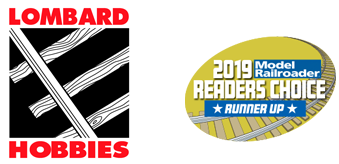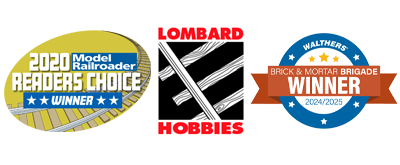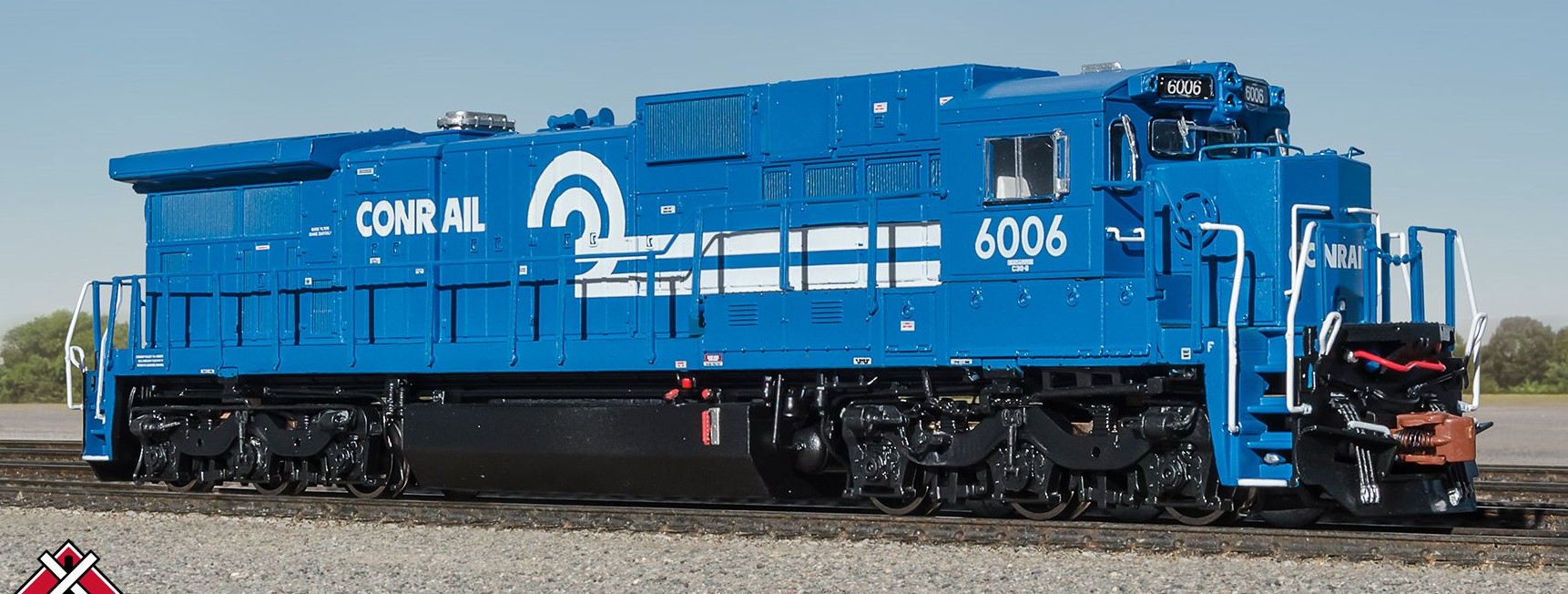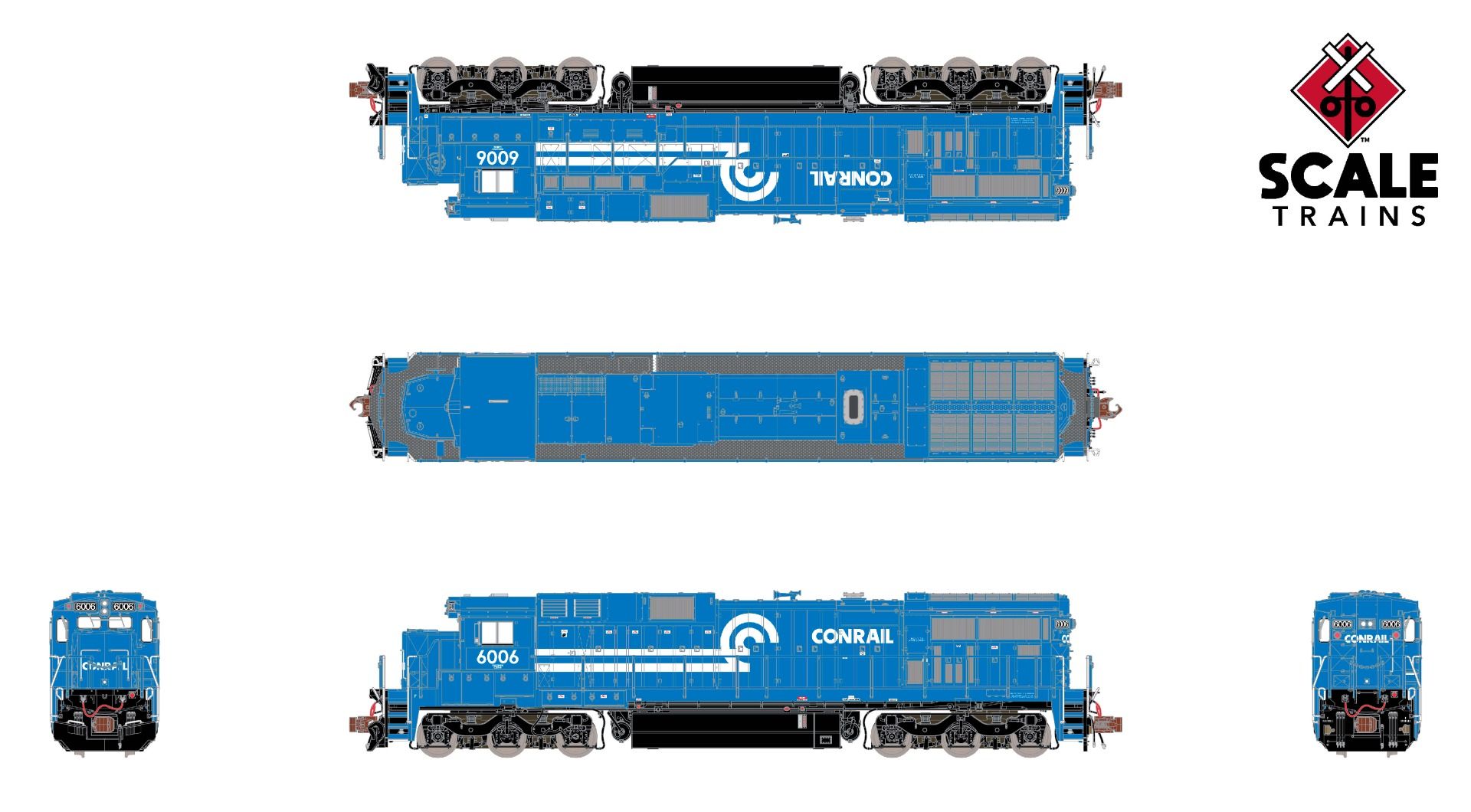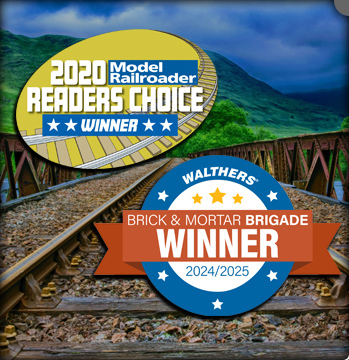ScaleTrains N
ScaleTrains Rivet Counter N SXT39177 DCC/ESU Loksound 5 Equipped GE C39-8 Locomotive Phase III Conrail '1990s Era' CR #6010
- In Stock:
- 1
- Scale:
- N
- SKU:
- SXT39177
Description
Please note picture is representative of the item but may not be same road number. Always refer to product description for actual product details.
ScaleTrains Rivet Counter N SXT39177 DCC/ESU Loksound 5 Equipped GE C39-8 Locomotive
Phase III Conrail '1990s Era' CR #6010

Road Number Specific ScaleTrains
- New road numbers
- Series 6000 to 6021; built 1986
- Road numbers 6006, 6010 and 6021
- Era: early 1990s to late 1990s
- Conrail 'Can Opener' Scheme
- Fully-assembled
- Multiple road numbers
- Non-operating front and rear class lights with lenses
- Printed and LED-illuminated front and rear number boards*
- Operating LED-illuminated headlights*
- Phase III - cab with square-corner doors, embossed X-panels on the hood end and nose sides, flush radiator grills with an additional small vertical screen, and no vertical grab iron strips on the long hood end
- Retrofitted 'inverted-L' nose grab irons
- Retrofitted tall vertical grab iron on rear end of long hood
- Small front Conrail-style plow with grab irons
- Semi-scale standard Type E knuckle couplers – Micro-Trains compatible
- Body mounted coupler box – accepts Micro-Trains 1015/1016 couplers without modification
- 3-hose multiple unit MU hose clusters with silver gladhands
- Front large anticlimber; rear drop step
- GE 'nub' tread plate on walkways
- Short hood without blanked lower headlight housing
- Wheel handbrake
- Detailed cab interior with floor, rear wall, seats, and control stand
- No sunshades
- Single wind deflector with mirror mounted in front of sliding cab windows on both sides
- Leslie RSL-3R horn mounted on offset pedestal on engine compartment
- Large and small Sinclair 'Excalibur' cab roof antennas, communication and End of Train EOT
- Left side dynamic brake cab: standard dual blower dynamic brake
- Dynamic brake cab roof
- Dynamic brake cab roof with dual panel grilles
- Right side dynamic brake cab: front two hinged and latched doors and bolted rear panel
- Early 6-panel radiator exhaust photo-etched grilles
- 'Bathtub' exhaust silencer
- Accurately profiled frame with separately applied plumbing and cabling
- GSC trucks with Hyatt bearing housings; separate brake cylinders, center axle shock snubber, brake lines and handbrake chain detail; and separate sanding lines and brackets
- Dual Graham-White Prime finned 075 air filters
- Highly-detailed 4,400 gallon fuel tank with fuel fillers, round and vertical fuel gauges
- Air reservoirs with separate plumbing
- Factory-applied wire grab irons, spare knuckles, trainline hoses with silver gladhands, MU cables, uncoupling levers, windshield wipers, underframe bell, and more
- Motor with 5-pole skew wound armature
- Dual flywheels
- All-wheel drive
- All-wheel electrical pick-up
- Printing and lettering legible under magnification
- Operates on Code 55 and 80 rail
- Durable packaging safely stores model
- Minimum Radius: 9 ¾”
- Recommended Radius: 11”
DCC & sound equipped locomotives also feature:
- ESU-LokSound 5 Nano DCC & sound decoder with 'Full Throttle'
- Cube-type speaker
- Accurate FDL-16 prime mover and auxiliary sounds, horn, bell, and more
- Operates on both DC and DCC layouts****
DC/DCC ready locomotives also feature:
- Operates on DC layouts
- DCC ready with Nano connector****
* Lighting features operate when using an ESU decoder with appropriate programming while operating using DCC
** In DC operation, both front ditch lights illuminate; rear ditch lights (if equipped) do not illuminate
****Lombard Hobbies Recommendation - As modelers ourselves we highly recommend ONLY running DCC on DCC systems and DC on DC systems, regardless of 'Dual-Mode' capability. This gives optimum performance and safeguards the unit from possible damage from running on a different system than originally intended and from any inexperienced operator errors.
Prototype History:
As the 1980s began, and with the success of their DASH 7 series, introduced in 1976, locomotive builder General Electric sought to build upon their momentum with an improved line of locomotives. Based upon technological advances and customer feedback, GE debuted its 'Dash 8' series in 1983. Featuring improvements to the FDL series prime mover and microprocessor controls, the DASH 8 line promised improved performance, as well as improved reliability and maintainability, over their DASH 7 predecessors. One of the first models to be unveiled was the C39-8, with a pair of testbed units built and painted for Norfolk Southern, numbered NS 8550-8551.
While keeping the clean contours of the long hood and rounded cab roof, two characteristics of the DASH 7 series, these new DASH 8s featured larger, angular radiator 'wings' at the rear of the carbody, an angular low short hood, and a boxy dynamic brake and clean air compartment at the front of the long hood, which jutted above the cab roofline. The NS testbed units made an imposing sight in their black paint, and were soon joined by an additional 12 units, NS 8552-8563, built in 1984. While similar to their testbed siblings, these additional units featured slight changes to their carbodies, known as 'phases' to railfans and modelers. The testbed units would be dubbed 'Phase Ia', while NS 8552-8563, with slight production changes to their radiator grills and dynamic brake compartment would be known as 'Phase Ib' units.
Pleased with their performance, an additional 50 units were delivered in 1985, NS 8564-8613. 'Phase II' units, they differed from the previous orders by featuring high-capacity dynamic brakes that resulted in an additional dynamic brake intake and exhaust opening, for a total of three, a handbrake wheel instead of ratchet handbrake, and a larger 4,400 gallon fuel tank replacing the 3,900 gallon tank of previous orders. Also eliminated were the vertical grab iron 'ladder strips' on the end of the long hood. Rounding out the NS fleet would be an additional 50 units, built in two batches of 25 units each, NS 8614-8638 and NS 8639-8663, delivered in 1986. These so-called 'Phase III' units would feature even more subtle changes; the radiator grills at the end of the long hood featured a slightly different configuration and a flush mounting, the cab doors changed to a square-cornered design, and the units featured a tall 42” snowplow at both ends, in contrast with the smaller 35” plow of previous deliveries.
Just when it seemed like NS would be the sole operator of the C39-8, eastern carrier Conrail ordered 22 units, delivered as CR 6000-6021, in 1986. Phase III units that shared some common features as their NS contemporaries, they did have some physical differences unique to Conrail; single-color red marker lights were installed instead of the tri-color class lights found on the NS units, and a massive anticlimber assembly was installed on the front pilot. Delivered in Conrail’s attractive blue and black scheme, they featured the then-standard large Conrail 'Wheels on Rail' logo on the long hood.
On the NS, the C39-8s could often be found hauling one of NS’s key commodities at the time: coal. Setup with bidirectional control stands, it wasn’t uncommon to see a C39-8, or several, working long-hood first on a lengthy coal drag on NS territory. Conrail’s small fleet was commonly seen working on a variety of assignments, from mixed freight to intermodal. Both CR’s and NS’s C39-8s could be routinely seen operating as run-through power on connecting railroads, such as CSX, Union Pacific, and Southern Pacific. CR and NS C39-8s have been photographed far away from home; they’ve been seen as far west as Long Beach, California, operating on the Southern Pacific. In fact, a power-hungry SP leased Conrail C39-8s in the early 1990s, with the leased units featuring a small red 'L' painted on their cab sides, signifying their leased status, and adding a splash of color to SP motive power consists over the system.
As the years and miles added up, the C39-8s of both CR and NS would undergo small physical changes. To aid crews climbing aboard, small vertical grabs would be added to the nose fronts of the NS units, while Conrail opted to add large 'inverted-L' grabs to the noses of theirs for the same purpose. Repaints in later years would introduce new paint scheme variations; some NS units would receive dashed white sill stripes, while some CR units would receive solid white frame stripes. Several CR units were noted to receive the 'Conrail Quality' paint scheme, as well. Their as-built class lights eventually disappeared from the NS fleet, and by the mid-1990s, FRA-mandated ditch lights began to appear on both the CR and NS fleets.
The year 1998 brought more change, as Norfolk Southern and CSX acquired Conrail. The eastern giant was split between the two carriers, including locomotives and rolling stock. NS received 13 former CR C39-8s, while the remaining 9 CR C39-8s went to CSX. While most kept their blue paint, gaining a 'patch' renumber into the CSX fleet, four of them received CSX paint - two painted in YN2, and two receiving YN3. Norfolk Southern repainted several of their former Conrail C39-8s as well, exchanging their coats of Conrail Blue for NS black.
By the early 2000s, with many miles racked up by the C39-8s, and newer, more reliable and fuel-efficient locomotives coming online, the trailblazing GEs began to be set aside in deadlines, with many meeting the scrapper’s torch. Some were spared that fate, being exported to Central America, home to railroads with a healthy appetite for used US locomotives. A handful found new homes on US shortlines and lease operators, but their use was to be short-lived. As of this writing, the only examples in operation in the US are a pair of former Conrail, by way of NS, units in use by eastern shortline Pennsylvania Northeastern Railroad. While no longer hustling along the high iron with long coal or hotshot intermodal trains in tow, the PNRR’s pair of units operates regularly, and represents the last of GE’s pioneering early DASH 8s.
Lombard Hobbies - Your #1 Largest Authorized ScaleTrains Select Retailer!
